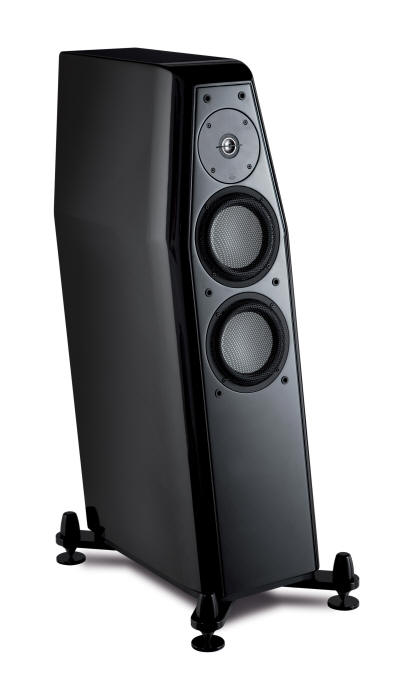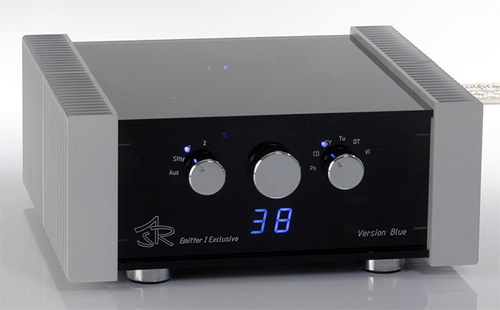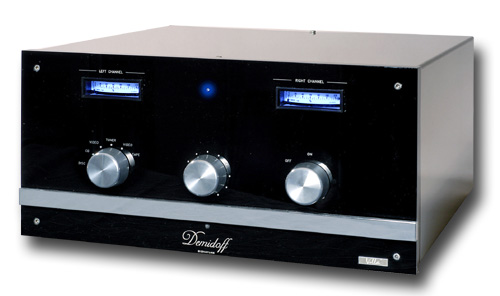
You are reading the older HTML site
Positive Feedback ISSUE
may/june 2008
kharma
CRM 3.2.2 loudspeakers
as reviewed by Marshall Nack

|
Has this ever happened to you? You're puttering around the house on your day off, going about your business, when out of the blue the crooning of a singer distracts you. She seems to be nearby and, what's more, sounds pretty good.
"I wonder where that's coming from," you mutter sub voce.
Gotcha!
In a flash, you realize—the voice is coming from your system in the next room. Fooled ya, once again! For a moment you were taken in and forgot that it's just another day tinkering around in your sound room.
Isn't that what we're all after? The goal is to put on a CD or LP and create that illusion over and over again.
Where can you find gear capable of generating that double take?
Synergy
I'm on the phone with my friend Marty:
Marty: So, how are the new Kharma CRM 3.2.2 speakers coming along (MSRP $33,500).
They're beauties, as nice to look at as listen to, and bonding amazingly well with the ASR Emitter I integrated amp. You know what? At the risk of sounding silly, I have to tell you: I'm not experiencing pangs of regret without my Kharma Exquisite-Midi speakers in line (MSRP $93,500).
Marty: Are you nuts? You can't say that.
Synergy
So much depends on our skills as a matchmaker.
I just spent the last two months listening to the ASR Emitter I Exclusive B integrated amp. The first month it was paired with my Kharma Exquisite-Midi speakers.

I was flying high. The ASR integrated pushes all the right buttons. Needless to say, the E-M pushes them all, too. The sound was on par with my reference—the mbl 8011 AM monoblocks, 5011 preamp, and these speakers. This was superb sound that I'm sure any rational audiophile would unhesitatingly consider delectable companionship for their imaginary desert island endgame.
I anticipated a serious letdown when I swapped in the newly arrived Kharma CRM 3.2.2 speakers, simply due to the fact they are five levels down the line. Certainly, most performance parameters did deteriorate, but in one important, unforeseen way, they surpassed the E-M. So, on balance, they held their own. Let me back up a bit and explain.
I rated the mbl 8011AM amps a best buy when I reviewed them. They sound terrific strapped to the E-Ms. But one must consider this speaker's nominal four-ohm load, dipping to the high two's. Even though they are reasonably efficient (90dB sensitivity), the rule of thumb is the lower the impedance, the more difficult the load. The E-M is a tough load for an amp to grapple with.
The 8011 AMs are not an optimal match. They're not designed to carry this kind of impedance load. I know this from having sampled the next up mbl Reference Line 9007 monos paired with the E-Ms. Over the course of a couple of weeks, that pairing provided the ticket to a destination I shall not easily forget, establishing an enduring high-water mark. (For the record, the 9007s spec 570 into four-ohms, and have a grand 1900 watts available at peak power. The 8011 AMs spec 310 watts into four-ohms, with a peak power rating of 1100. And the Emitter specs nearly the same: 290 into four-ohms. There's more involved, but power ratings can give you a good indication of an amps' ability to handle a speaker.)
Reality and practicality came knocking, however, droving my decision to acquire the 8011 AM monos: they are smaller and weigh less than the 9007s, of course, but mainly they cost a hell of a lot less.
So the E-M was holding back, through no fault of its own—through no component's fault actually—because so much depends on synergy.
Vitality
Like any other component, speakers more or less replicate changes in the signal to the best of their ability. An action commences, the signal changes, and they give you an indication of what happened. But it's never complete. Either it's stifled, like when a crescendo runs out of gas and hits a ceiling before the musicians have completed the phrase, or maybe it changes quality and becomes hard and glassy. Consider that this kind of blockage can be overall, the sound just poops out and stops expanding, or it can affect particular frequencies. Typically it's the bass that poops out, but it's possible anywhere, in the upper-mids, for example. There isn't a speaker made, or an amp, that gives you true-to-life dynamics. The guilty party may even be the interface between them, how the two react together. (This is the situation with the mbl 8011s and the E-M). The outcome is the same: it's left up to your grey matter to fill in the shortfall.
When an amp and speaker are working synergistically, a more complete action is possible. If they rise to the occasion, and still manage to maintain coherency and overall quality, the net result is going to be far more convincing.
What happens in such a relationship?
The amp becomes the master and the speaker its willing slave. When the amp barks out orders, the speaker says "Yes, sir!" and snaps to attention. What it means is whatever signal the amp is passing is transmuted into SPLs with a BIG source of distortion removed from the chain. What it means is you get the clearest and cleanest sound either component is capable of. You hear more signal and less mechanical artifact.
Here's where we factor in an amp at the caliber of the ASR Emitter I and a transducer at the level of the CRM 3.2.2. The Emitter I is very nearly a category killer in terms of the quality and range of its dynamics. And the CRM 3.2.2, with the same 90 dB sensitivity as the E-M, makes this amp much happier. With its nominal six-ohm load not dipping below four, the amp has a load it is designed to handle.
The CRM 3.2.2, for its part, is in its element. With sufficient damping factor provided by the amp, driver recovery time is optimized. The signal moved around over Kubala-Sosna wires fast as blazes, able to throw quick jabs and recover without leaving an opening, so to speak. There's no blockage, no stifling of the intent. Imagine for a moment a no-nonsense sound field. There's no fog, no mist, it's like a clear, sunny day, like looking out at the ocean and seeing for miles, the kind of day photographers dream about, the kind of day featured in too many of those allergy medication commercials. The colors are all pure and crisp; vision is 20/20.
Sure, it's a matter of transparency and detail retrieval. Clearly these, and everything else on the check-off list, can't be laggards. But there's something else.
The CRM 3.2.2 has an inordinately energetic transient response, such that the smallest dynamic shadings are made obvious. And it allows the biggest dynamic shifts room to expand. (Not to say full expansion, but enough to make you feel it's not blocked.) It has dynamic openness. This is very often the missing ingredient that prevents our suspension of disbelief. And it is the CRM 3.2.2s most outstanding characteristic.
Dudes who came by to hear this system simply uttered, "Yeah. That's got it."
Kith 'n Kin: the CRM 3.2
FAQ: What does it have in common with its little brother?
You may recall when the Kharma CRM 3.2. was introduced seven years ago, it rocked the high-end firmament. It was the toast of the town. This world-famous two-way punctured long-standing barriers and pushed the outer limits of transparency.
It may be two years since I had the CRM 3.2 in my living room, but I can still tell that the sound of the CRM 3.2.2 comes from the same place—as it should, being designed to follow in its footsteps.
All of the sibling traits are there: the same disappearing act; the see-through or see-into soundstage; the purity and speed; the major league frequency integration and transient coherency; the timbral treatment; even the size and shape of the soundfield and its characteristic images. In short, if you ever heard the 3.2s, you'll recognize the sound of the 3.2.2s.
Appearance-wise, the CRM 3.2.2 falls in with the rest of the Ceramique line and is up to Kharma's reputation for the finest finishes. I'm sure it's a considerable factor in its pricing (MSRP $33,500). The CRM 3.2.2, like its little sibling, will fit most small and medium rooms, where they visually and sonically disappear. Parts quality is the same: internal wiring is Kharma silver-gold wires; there are the Kharma cross-braced SDSS stands; the heavy-duty spike feet, and a rear port.
A couple of guys complained about warm and loose bass, which they attributed to the port. It turned out, they all own sealed enclosure speakers. They are used to the tight and tuneful bass that design produces. This is a matter of taste. Personally, I find this kind of bass overly tight and unnatural.
FAQ: How does it differ from its little brother?
The obvious physical differences are the addition of a second 7" concave Accuton ceramic driver and the larger cabinet size, but there's more.
For one thing, the tweeter is new. The CRM 3.2.2 employs a re-designed, in-house manufactured tweeter. The one on the CRM 3.2 I knew had a tendency to dominate and was somewhat thin—actually, flesh was somewhat thin all around. Occasionally it threw temper tantrums. It was excitable. (I'm talking about the first production CRM 3.2s, which had a 1.5" inverted-dome titanium, Kharma-modified, Focal tweeter. Current production CRM 3.2s use the same tweeter as the CRM 3.2.2.) The CRM 3.2s are also brighter sounding, albeit, it's treble is supple and nuanced. The space conjured by the CRM 3.2s is smaller, more intimate and seductive.
The CRM 3.2.2s treble is more controlled and I'm happy to report, has more flesh and body in keeping with the frequencies below. Still, there is no excess here—you don't want to mate it with analytical ancillaries.
The design is called a 2.5 way, where the identical mid/bass drivers cover overlapping frequencies. This necessitates a more complicated crossover than the CRM 3.2, a true two-way, but for the life of me, I can't hear it. Still, the CRM 3.2 is marginally more invisible. Note that both models spec down to 35 Hz, but oh, what a difference in output levels at that point! That extra mid/woof gives you a low-end with substantially more usable output. Another thing: the bigger and heavier cabinet (110 vs. 70 lbs for the CRM 3.2s), means the CRM 3.2.2s are able to move considerably more air and pressurize the room more fully.
The quantity and quality of the low frequencies is perfectly satisfying for the genres I listen to—classical and acoustic jazz—even enough to suggest a full orchestra. You won't be thinking about augmenting them with a powered sub, as I did when I owned the CRM 3.2s, unless you're into amplified jazz or rock, which uses synthesizers and such.
With the mbl Noble Line Separates
Now I put my mbl Noble Line separates back in line, keeping as many variables as I could the same.
First of all, I was surprised at how closely the tonal balance matched to the ASR. It didn't require gross adjustment or re-voicing. That said, the mbl didn't have the hefty wallop down below, or the sparkle in the treble. The leading edge wasn't as pronounced and transient weren't as dramatic. But the mbl excelled in control. (I had thought the ASR was supreme commander in that area.) The mbl brings a more even, more accurate frequency response that's warmer, sweeter and with noticeably more body than the ASR.
All of these attributes were strong clues that I needed to re-tool with a mass of TARA Labs cable—The One power cords throughout, The Zero digital link and The 0.8 ICs. This brought back most of the transient snap, along with more refinement and higher information retrieval. Funny, with the mbl amplification, I was moving in TARA Labs cables to boost the vitality of the sound; with the ASR, I had to optimize with K-S.
When I inquired if it still had "it" in this configuration, the comments were split fifty/fifty. One set of golden ears said, with a smile, there's more "it." Another said, "No, the transient isn't as exciting and ‘it' is gone." Personally, I thought it had the spark of life as much as before.
With the Bluenote Demidoff Integrated Amp

Lastly, I paired the CRM 3.2.2 with the fifty-watt single-ended, solid-state Bluenote Demidoff Signature Integrated Amp (MSRP $6900). Now it was clear that "it" had vanished. The Demidoff's dynamics didn't have the range to send the big stuff where it wanted to go. It didn't have dynamic openness. But, you know what? Once again tonal balance was right on. This gave me pause. Three amps in a row had a consistency of tonal palette. Is this a coincidence, or is the CRM 3.2.2 imparting a tonal coloration? Dunno.
Kith 'n Kin: the Exquisite-Midi
Now, before you start to think either I've gone bonkers or there's nothing more to be had from a transducer, let me hasten to bring in another speaker for comparison: my reference Exquisite-Midi's.
No, the CRM 3.2.2 crescendo doesn't have the visceral power of the E-M. No, it doesn't have the micro-dynamic shadings. Concerning both dynamic extremes, the E-M is world-class, period.
At first I thought the CRM 3.2.2 had more vitality in the mid range, but after a while, I realized it's really another manifestation of its energetic transient and the optimized amp / speaker interface.
Both speakers throw comparable proportions in the width and height at the front of the soundstage, but the E-M is able to go prospecting deep into the furthest recesses. The CRM 3.2.2 tapers the rear corners into a hemisphere. Its images are more transparent, so you could visually walk in and between them.
The E-M is warmer, darker and much fuller. It has a saturated, sweet and woody tone color. E-M images are more life-sized, massive and sculptural, its stage more dense. To take apart its sound is like dissecting a cadaver. Under the flesh there's layers of stuff: internal organs; vital fluids; eventually, there's bone. It continues to exfoliate. There's an incomparable performance to be had from the ultra-luxurious Exquisite-Midi. The CRM 3.2.2 sound, on the other hand, has none of this layering. You get flesh and bone. But the E-M could not do "it" with the amps on hand: its transient approach is less exciting, its attack softer.
Conclusion
It was with unmitigated astonishment and great delight that I did not suffer debilitating remorse when I substituted the Kharma CRM 3.2.2s for my Kharma Exquisite-Midi speakers. No doubt you'll find that an incredulous statement, given that the newbie lists at $33,500 while my E-Ms are now a staggering $93,500. Let me quickly qualify that: I'm not saying the CRM 3.2.2 is the better speaker. The point I'm making is the evaluation of a product occurs within the context of a system.
The E-M, with its nominal four-ohm load, presents a burden beyond the reach of the amps on hand. That is why a speaker like the CRM 3.2.2 can come along and do things its bigger sibling can't. The CRM 3.2.2 is a dream-team match-up with these amps.
First they were paired with the ASR Emitter I Exclusive B, a very fine integrated amp, and K-S wires. Quite the opposite of remorse, in short order this recipe achieved a startling level of realism that left the best ears on my listening panel nodding like bobble heads a unanimous and unequivocal, "Yup. That's got it." First time that's happened. Then they were mated with my reference mbl separates and TARA Labs wire and yes, this had "it" too.
The Kharma CRM 3.2.2 is the worthy successor to the world-famous CRM 3.2. It has a recognizably similar voice and like it, the CRM 3.2.2 puts over a speaking-with-one-voice Houdini act the equal of any magician-level transducer you'll encounter. Differences with the CRM 3.2 are a newly designed tweeter and a second 7" mid/woof. These have the effect of lowering the tonal balance and serving up much more low frequency output. You will not be thinking about a sub to go with the CRM 3.2.2.
But the biggest difference is the inordinately sensitive and energetic dynamic response of the CRM 3.2.2. The smallest dynamic shadings are made obvious, and the biggest dynamic shifts are allowed room to expand. It has dynamic openness.
The CRM 3.2.2 does everything well, some things up at SOTA level. Believe me, I looked high and low to find something to criticize—and came up with nada. The only question the consumer needs to ask is "Does the CRM 3.2.2 speak with the kind of voice you're seeking? Does it express your musical taste?" Marshall Nack
CRM 3.2.2
Retail: $33,500 a pair
Manufacturer
O.L.S. Audiotechnology, The Netherlands
web address:
www.kharma.com
Distributor Information
GTT Audio/Video
356 Naughright Rd.
Long Valley, New Jersey 07853
TEL: 908. 850. 3092
email address: [email protected]
web address:
www.gttgroup.com
